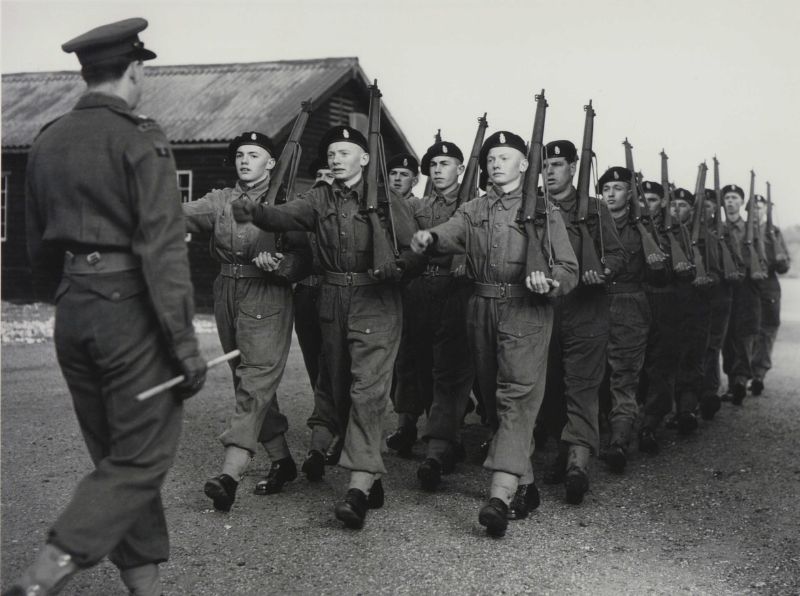Did your family member serve with the armed forces under National Service? Perhaps they shared stories of their time in uniform with you, or you’ve stumbled on a photo in an album that sparked your interest. How do you research someone who served under National Service, and what records are available to family historians? Here’s some top tips on how to find National Service records.
Background
When the war in Europe ended in 1945, the process of demobilisation began, and thousands of service personnel were gradually released from uniform back into civilian life. Britain, however, still had global commitments that required a military presence. To satisfy the manpower requirements, conscription would have to continue.
National Service was the solution: compulsory military service, essentially peacetime conscription in Britain (not Northern Ireland). When it was initially agreed on in 1947, all males between 18 and 30 would be liable for military service. This was subsequently reduced to include 17-21 year olds from 1 January 1949. Service was for 18 months but extended to two years on the advent of the Korean War in 1950.
National Servicemen were eligible for service in all three branches of the armed forces and could be sent overseas. Some conscripts served during wars and emergencies like the Korean War, in Malaya, or in the Suez Crisis. Over two million men were called up for the armed forces during National Service, which finally came to an end in 1963. Perhaps your ancestor was one of them?
FWR Tip: Have a photo of an ancestor in uniform? Forces War Records full members have access to the Document Expert feature, allowing them to send photos for analysis from one of our military experts.
Start with a search
Know your military ancestor’s name? Perhaps you know their regiment or number? Start with a search of Forces War Records to see what we hold on them. We’ve created a handy video on our Facebook page on how to search our site, which may help you get started.
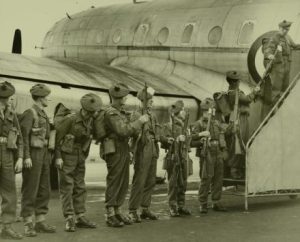
Service Records
Just like researching your ancestors who served in WWI and WWII, a service record is the ultimate source for researching National Servicemen. It is the most complete record of your ancestor’s service, allowing you to build a timeline of the key events from their time in the military.
A service record will indicate when they enlisted, who they served with, their promotions, where they served, if they were wounded and when they were discharged. The clues held within a service record can help you search other collections, too.
For a long time, British Army service records were held by the Ministry of Defence. At the time of writing, around 9.7 million British Army service records are being transferred to The National Archives in Kew for permanent preservation. The transfer includes other ranks’ (non-officers) service records from 1921-1963. It’s a huge project and very exciting for us as military family historians. To apply for the service record of someone who completed National Service with the British Army and was not an officer, complete the online form via The National Archives website. It should be noted that owing to the size of the project and the demand for records, there is a significant wait time for service records.
British Army officers’ records are still held by the MOD. You can apply for their service records via the MOD website.
FWR Tip: When studying your ancestor’s British Army service record, look for the ‘Service and Casualty Form’. This section will help you piece together their movements and form a timeline of their service.
What other National Service records are out there?
Medal Records
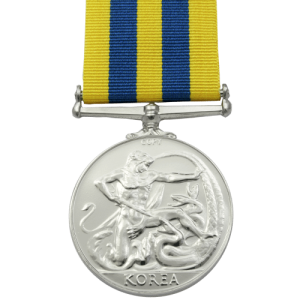
Medal records can be a vital source for family historians, offering useful military details and, sometimes, genealogical information. The clues held within, like an army number or regiment and battalion, can help you target other military records, such as service records or casualty databases.
Whether you’re at the beginning of your research journey or a seasoned pro, medal records are always of great interest and value.
We have a diverse selection of medal collections available on Forces War Records, covering specific wars or campaigns to General Service Medals for service in particular areas or operations.
You may find someone conscripted under National Service in any of the following medal collections:
- Korea Medal, 1950-1953
- Medal for Suez Canal Zone, 1951-1954
- General Service Medal Awardees, 1881-1982
FWR Tip: From WWII onwards, if a service person never applied for their medals, their next of kin can apply via the MOD.
War Diaries
British Army war diaries are a crucial source for researchers of WWI and WWII, providing a fascinating insight into the day-to-day activities of a battalion. War diaries were gradually phased out after WWII, though you will find a small selection post-1945. For example, The National Archives (TNA) holds war diaries for the Korean War and the Suez Crisis, both involving conscripts on National Service.
By 1950, unit war diaries had largely been replaced by quarterly historical records and reports, also available from TNA.
FWR Tip: Looking for contextual records of the Royal Navy or Royal Air Force? Royal Navy Ships’ Logs are held at TNA, while Ancestry holds a wide range of RAF Operations Record Books.
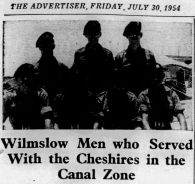
Newspapers
Newspapers are a fantastic source for anyone researching their military ancestors, including those on National Service. Local newspapers sometimes published letters of personnel serving overseas or printed their photographs. You may find references to someone who joined up, was killed in action, taken prisoner or was awarded for bravery. Newspaper articles can contain revealing information not found elsewhere, the kind of information that may get lost over time, so they are incredibly valuable.
Newspapers.com has a free 14-day trial to help you get started.
Researching Casualties
Consider the Soldiers’ Effects Records when researching post-WWII British Army Casualties. The records detail any money or war gratuities owed to soldiers who died in uniform, whether this was during active service, peacetime duties or home service. On Forces War Records, we hold the Soldiers’ Effect Records for the period covering 1901-1929. For anything after including the period covering National Service, consult The National Army Museum’s archives.
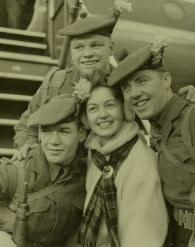
Prisoners of War
You’ve established that your National Service ancestor may have served in Korea, but what if they were a prisoner of war? Around 1,060 British personnel were taken prisoner or deemed missing in action during the Korean War. Search for their names in our Korea – British Army Prisoners of War, 1950-1953 collection.
Regimental Museums
Don’t forget to make use of regimental museums. They are great places to visit and often have excellent archives with helpful and knowledgeable staff and volunteers. Although they rarely hold records of individual soldiers, you may find photo collections, contextual records or even references in regimental journals or chronicles.
FWR Tip: Remember to search for regimental histories, outlining the activities of regiments at different stages. You may find them at regimental museums or digitised online.
Cover image: © Hulton Archive/Getty Images
Sources:
GOV.UK, Korean War 60th anniversary events, accessed January 2024.
GOV.UK, Records transferred from the Ministry of Defence to The National Archives, accessed January 2024.
National Army Museum, What was National Service?, accessed January 2024.
UK Parliament, National Service, accessed January 2024.
The National Archives, British Army operations after 1945, accessed January 2024.

